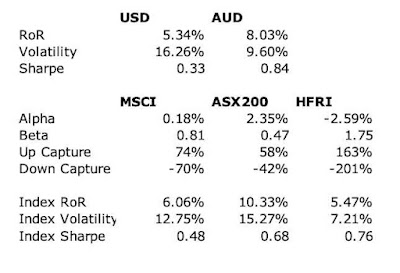I'm still waiting for one final piece of data for the October report, so in the meantime here is the much-delayed September report. This report will be pretty short as I'm
no longer comparing results against annual goals and there'll be more detail in the October report. Also, these results are so bad I don't really want to analyse them too much!
Both September and October's results are heavily influenced by the decline in the Australian Dollar that took place in this period. This has the effect of reducing both our expenses and non-investment income in US Dollar terms and making investment returns in USD terms much worse than in Australian Dollar terms.
Income and Expenditure
Expenditure was $2,996 ($A3,674). Non-investment income of $3,618 ($A4,436) mainly consisted of Snork Maiden's salary. Retirement contributions were $539. Total investment losses were $71,412, which is a record loss. $11,648 of this was due to the fall in the AUD. In AUD terms we lost $A64,651 with a positive $8,641 contributed by the rise in the USD. The currency neutral loss is worse than the estimate of October's loss.
Investment returns are reported pre-tax. Australian retirement account earnings are taxed at 15% (10% for long-term capital gains). A fall in the value of the account reduces the tax liability and so the actual account value falls by less than our estimated pre-tax investment returns on the account. Reduction in the tax liability on these accounts kicked in $2,756 to the change in net worth.
Net WorthNet worth fell by $67,496 to $324,821 or in Australian Dollar terms by $A59,849 to $398,358. At month's end retirement accounts stood at $172,541 and non-retirement accounts at $152,280 ($A211,603 and $A186,755).
Investment Performance
Investment return in US Dollars was -18.2% vs. a 7.59% loss in the MSCI (Gross) All Country World Index, which I use as my overall benchmark and a 8.91% loss in the S&P 500 total return index. Returns in Australian Dollars and currency neutral terms were -14.11% and -15.23% respectively. My previous worst return was in September 2002 when the loss was 17.96% (17.13% in AUD terms).
So far this year we have lost 29.47%, while the MSCI has lost 21.04%. We are still beating the market over 5 years and 10 years in USD terms but trailing in all the more recent timeframes.
Asset AllocationAllocation was 49% in "passive alpha", 63% in "beta", 1% was allocated to trading, 8% to industrial stocks, 4% to liquidity, 4% to other assets and we were borrowing 29%. Due to the use of leveraged funds, our actual exposure to stocks was 128% of net worth. Leverage declined due to the restructuring following the
margin call from CommSec. In August we were borrowing 36 cents for each dollar in equity; we are now borrowing 29 cents. Taking into account leveraged funds borrowing declined from 89 cents to 82 cents per dollar of equity. Looking at asset classes:

We halved exposure to bonds but kept stock exposure as a fraction of gross assets constant. I've also included a tentative long-term allocation for the first time. We're not going to move our allocation towards these targets in the short-term, but they indicate where we'd like to be a few years from now. I've allocated 10% to each of bonds, hedge funds, private equity, commodities, and real estate, which is totally arbitary. We would like to have about half of total assets in these categories as against about 30% now. But I really don't know if 5% or 10% is say the appropriate allocation to private equity given the limited options available to retail investors. I am pretty sure though that more real estate and
managed futures would be good.
There is a bit more science behind the equity allocations. The Australian equity exposure is double the foreign exposure. The allocation to large cap vs. small cap reflects the 78% of Australian market capitalization in the ASX 200 stocks. The breakdown between US and rest of the world stocks reflects that 50% of world market capitalization is in the US.
Anyway, in the next few years I plan to scale back exposure to large cap Australian stocks and increase exposure to real estate, bonds, and commodities if and when global stock markets recover. I'd also like to get overall leverage down to about 30% or so.
At the end of September currency exposures were roughly 54% Australian Dollar, 24% US Dollar, and 22% Other and Global.






































